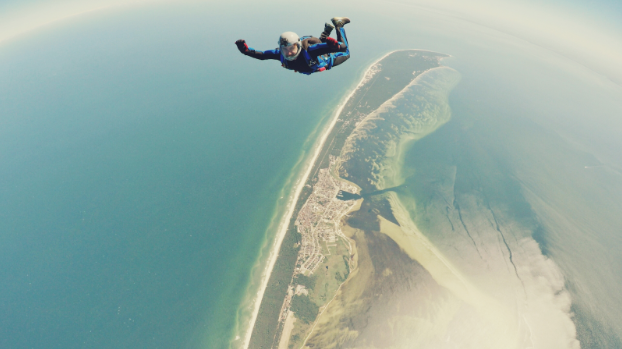We all get tired of the same kind of date night. How many times have you done dinner and a movie, or ordered in with Netflix? Perhaps it’s time to think outside of the Redbox. It’s common for couples to seek out a new or unique activity once a year on an anniversary or special occasion that checks an item off of their bucket list. But why wait for a specific day, when you could shake up this weekend’s date?
Take the ultimate “leap of faith” and share a skydiving experience together. You and your partner don’t have to be thrill seekers to enjoy stepping out of your comfort zones. There are plenty of safe, certified skydiving instructors nationwide that can help you do just that.
Skydiving is the ultimate adventure to take with the person you love at least once in your lifetime. It will give you a rush that’s better than any car chase you’ll see in an action movie at your local theatre. Take your pick from some of the best skydiving dropzones all over the U.S., as the first choice you’ll have to make is where to go and when to do it. There are even different types of skydiving that you can choose from, depending on your comfort level and how much of an “adrenaline junky” you are.
When deciding to jump, you’ll need to consider what type of dive you’d like to try. Who knows, you may end up loving the rush so much, that you’ll go from your first basic skydive to earning your own license! For others who want to jump just once to say “I did it!” there’s the assisted tandem skydive. Plenty of companies will document the experience for you no matter how you decide to drop, allowing you and your partner to cherish the memory permanently. Be sure to take some time to consider the pricing, location, and services offered at your local dropzones.
Tandem Skydiving
This is the most common type when going on a first skydive. Tandem skydiving allows you to make the jump with a certified diver, typically on your back, who will help guide you through the fall. It’s the best introduction to the sport of skydiving, as it allows you to jump safely without having to maneuver the equipment unassisted. It also has a shorter preparation time compared to other types of skydiving, as you only need to know how to position yourself in accordance with your jump partner. You’ll take in the unbelievable experience while letting a seasoned jumper take the reigns of your adventure. Most tandem dives take place around 10,000 – 14,000 feet up. They can also be utilized for training courses for anyone who wants to try their own freefall. It allows new jumpers to learn and become familiar with the techniques and procedures before attempting anything solo.
Static-line Diving
This type of jump requires a full day on the ground in preparation for the dive. These falls take place around 4,000 feet. The parachute will open automatically by a “static-line” that is attached to the aircraft. Static-line dives occur without any actual freefall and are often required for those hoping to dive solo, as they get familiar and comfortable with the technique unassisted.
Skydive training can be both mentally and physically draining, as solo diving does come with risks. Oftentimes a full skydiving training course occurs over more than one day if you hope to jump alone – the static-line jump often happens the following day. Static-line diving helps divers learn how to correctly position their body, how to properly exit the aircraft, and how to execute the proper safety measures during a jump. It also becomes important to skydive regularly and frequently so that you become accustomed to the best practices.
AFF Diving
After completing your ground training and completing static-line dives, you are ready to work your way up to the AFF skydive, or Accelerated Freefall! This jump happens at 15,000 feet and allows you to freefall out of the aircraft on your own before pulling your own parachute chord. This is truly for the thrillseekers or those hoping to attain their licensure to do tandem jumps with others or frequent jumps on their own.
There are levels to training once you reach this point, and you’ll have to demonstrate your knowledge and ensure your safety before instructors will allow you to go completely by yourself.
When diving solo, this is when many jumpers become creative with their falls. You can work on positioning your body in different ways and performing jumps with 90 and 360 degree turns. This requires plenty of practice – not just on your own but with instructors who teach you how to perform stunts during a drop. It’s helpful to have your dives filmed, so that you can evaluate your performance and ensure you are being safe and positioning your body correctly. As you continue to train, the instructors that jump with you will use hand signals to help you adjust yourself while in the air.
No matter your experience level or what type of dive you’re performing, there are standard tips to keep in mind before heading off to a skydiving session: remove all your jewelry and piercings, keep your hair up, stay close to your instructor, and – most importantly – listen carefully. It is incredibly important that, as an inexperienced skydiver, you pay attention and follow the necessary safety procedures. Even if something sounds obvious during training, you can never be overcautious once in the air. Also, keep in mind that the weather plays a factor in your dive; poor weather conditions may cause delays or the need to reschedule. Try to plan your jump on a day with clear skies.
Has your interest peaked? Take your special date or anniversary to the next level and go on a skydive together! If you and your partner take to the sport, it can provide a great hobby that you can share in and train for together.
Add The Sports Daily to your Google News Feed!








